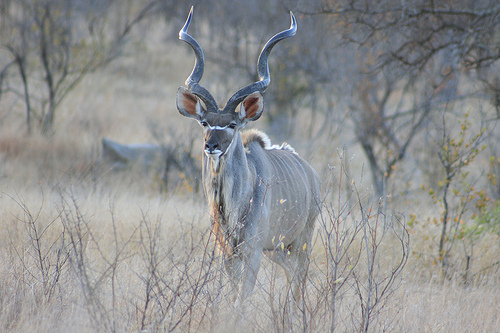Keep quiet while approaching a kudu.
- Kudus are two species of mammals similar to an antelope, and they are native to the savannahs of south and east Africa.
- Kudus have the scientific name Tragelaphus strepsiceros and Tragelaphus imberbis, known as the ‘greater’ and ‘lesser’ respectively, and are from the family Bovidae, the family of cloven-hoofed mammals.
- ‘Kudu’ is derived from the word ‘koedoe’, a term from the South African language, Afrikaans, that originates from a native Xhosa word.
- Female kudus can be found in herds of 24 or less, that usually include their young, and males generally live by themselves, although may collect in very small, same gender herds, and males may fight other males but are generally not territorial.
- A kudu has a brown-grey coloured coat that has a number of thin, light coloured stripes on it, and the ‘lesser’ species can run at speeds of 95 km/hour (60 miles/hour).
 A Kudu
A Kudu
Image courtesy of ale_speciale/Flickr
- The diet of kudus generally consists of vegetation such as leaves or newly sprouted twigs, as well as fruit.
- Kudus are preyed on by large cats, hyenas, snakes and wild dogs, and they often flee at the first sign of danger and hide among thick vegetation.
- Humans are causing kudu numbers to dwindle due to hunting for the hide, low-fat meat and horns, as well as destruction of habitats; and the ‘lesser’ species are listed as near threatened.
- Male kudus have long spiral horns that can be turned into musical instruments, that are often used during ceremonial occasions.
- Kudus grow to be around 0.8 to 1.2 metres (31 to 47 inches) in height and typically weigh 120 to 256 kilograms (265 to 565 pounds).
Bibliography:
Kudu, 2014, A-Z Animals, http://a-z-animals.com/animals/kudu/
Kudu, 2014, Wikipedia, http://en.wikipedia.org/wiki/Kudu






